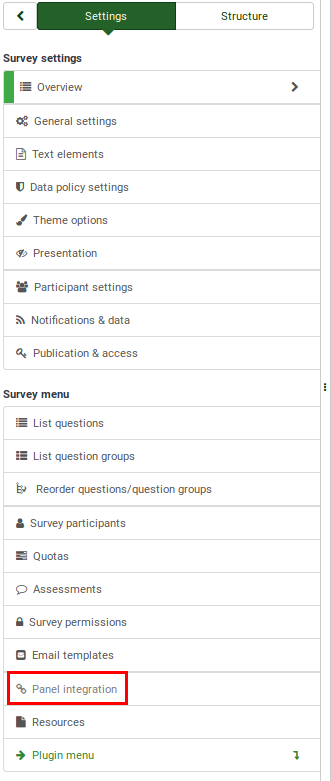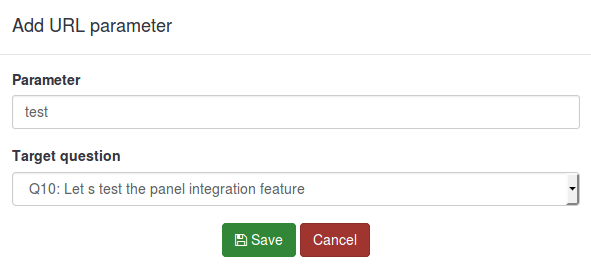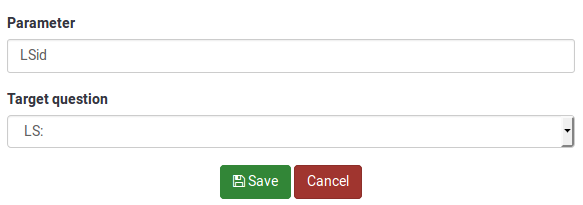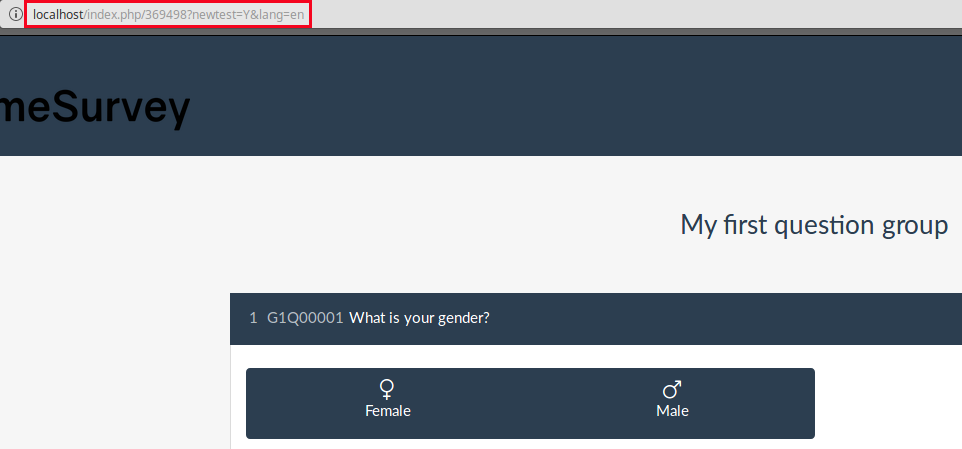Integración de paneles
From LimeSurvey Manual
Introducción
Desde esta pestaña puede definir los parámetros de URL que serán aceptados por su encuesta. (Estos parámetros se adjuntarán a la URL de inicio de la encuesta general). Esta opción es importante si desea integrar su encuesta con un proveedor de panel de encuestas profesional que le proporcione los participantes. Este último generalmente proporciona la identificación única de cada participante de la encuesta y deberá guardar estas identificaciones únicas para futuras referencias.
Integración del panel de la encuesta: Menú Encuesta > Menú Encuesta > Integración del panel

Integración del panel de encuestas
Se mostrará una tabla vacía con la opción que le permite agregar un parámetro de URL.

Es necesario completar dos campos:

- Parámetro: Escriba en este campo el nombre del nuevo parámetro.
- Pregunta de destino:. El valor del parámetro siempre se guarda en la sesión de la encuesta, incluso si no establece una pregunta objetivo aquí. Aquí podrás seleccionar una pregunta del tipo 'Ordenar texto' o 'Múltiples textos'.
Cómo utilizar la función de integración del panel
A continuación se presenta un ejemplo simple para explicar cómo utilizar la función de integración del panel.
1) Primero, cree una pregunta de texto libre corta/larga y asígnele el nombre que desee (usaremos "LS" para el campo Código de pregunta). Luego, active la opción ocultar siempre esta pregunta, ubicada en la pestaña Mostrar dentro del menú de la pregunta.
2) Vaya a la pestaña de integración del panel y haga clic en "Agregar parámetro de URL".
Seleccione la pregunta de texto corto/largo que creó en el primer paso. Los participantes que provengan del respectivo proveedor del panel profesional llegarán a la pregunta objetivo. Se puede ocultar para que los participantes puedan comenzar a completar la encuesta.

El nombre que elija para el parámetro deberá incluirse en el enlace de entrada que luego proporcionará al proveedor de su panel. En nuestro ejemplo se llamará "LSid". ¡No olvides hacer clic en el botón Guardar ubicado en la parte superior derecha de la tabla!
3) Now, you have to set up the entry link that you will send to the your panel provider. To get your survey URL link, click the Preview survey buttons.

Copy the URL you accessed from the address bar:

Add at the end the newly added parameter: &LSid="xxxxxx". The link should look like this:
http://localhost/index.php/369498?newtest=Y&lang=en&LSid="xxxxxx"
What ever you replace the "xxxxxx" with will be stored in the short/long free text question when your respondent lands on that page. For example, I sent to a user the following link:
http://localhost/index.php/369498?newtest=Y&lang=en&LSid=ABCD5
The string after LSid was stored as an answer to the short/long text question.

Examples
The following examples were created to help you add:
- Redirects if the respondents have finished filling out the survey;
- Redirects if the respondents were screened out due to a quota;
- Redirects link if the quota limit was reached.
The complete link
The complete link must be inserted into the end URL field that also has to be loaded automatically for everyone who successfully completes the whole survey.
The URL you have to send back to the panel provider should look like this:
https://panelproviderwebsite.com/?return=complete¶metername={PASSTHRU:parametername}
The screenout link
A screenout prevents the participants from continuing the survey because he or she is not a member of your survey target group. For screenouts, you have to set the quota limit field to "0" (zero) and allow the quota URL to be automatically loaded once it was triggered.
Then, add the following link into the quota URL field:
https://panelproviderwebsite.com/?return=screenout¶metername={PASSTHRU:parametername}
The quotafull link
A quotafull excludes participants from continuing the survey, because a certain quota has been exceeded.
https://panelproviderwebsite.com/?return=quotafull¶metername={PASSTHRU:parametername}